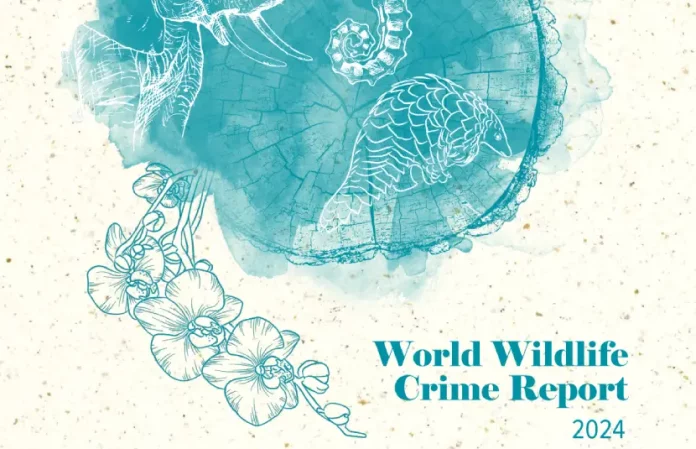
World Wildlife Crime Report 2024: The World Wildlife Crime Report 2024, unveiled by the United Nations Office on Drugs and Crime (UNODC) on 13th May 2024, sheds light on the illicit trade in wildlife spanning from 2015 to 2021. Let’s delve into its key findings, insights, and recommendations to combat this global threat.
Key Findings: Animal Species
The report identifies the rhino and pangolin as the most heavily impacted animal species:
- Rhino Horn Market: Leading with a share of 29%
- Pangolin Scales Market: Following closely at 28%
- Elephant Ivory Market: Constituting 15%
Other affected species include eels, crocodilians, parrots, and various others, each contributing to different percentages.
Key Findings: Plant Species
In terms of plant species, Cedars and other Sapindales dominate the illegal trade:
- Cedars and Sapindales Market: Holding the highest share at 47%
- Rosewoods Market: Following at 35%
- Agarwood and other Myrtales Market: Accounting for 13%
Additionally, species like golden chicken fern and orchids also face significant threats.
Seizures of Biodiversity Products
Seizure data reveals the following:
- Corals: Account for 16% of all seizures
- Crocodilians: Contribute 9%
- Elephants and Bivalve Molluscs: Each at 6%
Various other species make up the rest, showcasing the diverse nature of the illegal wildlife trade.
Commodity Seizures
- Coral Pieces: Represent 16% of all seizures
- Live Specimens: Makeup 15%
- Animal Product Medicines: Account for 10%
Other seized commodities include animal meat, shells, and small leather products, among others.
Report Insights
Despite global efforts, wildlife trafficking persists, underscoring the adaptability of traffickers. The report emphasizes the need for international collaboration, enhanced data capabilities, and modernized responses to combat corruption and technology-driven crime.
Recommendations
- Stronger Coherence and Cooperation: Stress on international collaboration across the trade chain.
- Increased Investment: Enhance data and analytical capabilities.
- Addressing Corruption and Technology: Tackle corruption and modernize criminal justice responses.
- Strategic Interventions: Prioritize measures to mitigate wildlife trafficking.
The report underscores the interconnectedness of wildlife trafficking and organized crime, advocating for comprehensive strategies to combat this menace.
Assessment and Impact
The report assesses the causes and impacts of wildlife trafficking globally, stressing the need for tailored solutions. It highlights the diverse factors driving trafficking and the importance of ongoing research to combat criminal structures and evolving demand patterns.
Data and Collaboration
Seizure data from 162 countries and territories during 2015–2021, impacting around 4,000 plant and animal species, is analyzed. Case studies on various affected species are included, aiding in understanding the extent of the issue.
Role of CITES and Collaboration
CITES serves as the primary legal framework for regulating international trade in endangered species and collaborates closely with organizations like UNODC, INTERPOL, and the World Customs Organization. The report will be instrumental in guiding global efforts to combat wildlife crime.
In conclusion, the 2024 World Wildlife Crime Report underscores the urgent need for coordinated action to protect our planet’s biodiversity from the threats posed by illegal wildlife trade.
Stay updated with the latest current affairs and insightful blog posts by following Freshersnow. Don’t miss out on future content that keeps you informed and engaged!
| You Can Also Check | |
| Current Affairs | |



